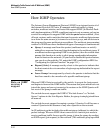
Multimedia Traffic Control with IP Multicast (IGMP)
IGMP General Operation and Features
IGMP Operating Features
Basic Operation
In the factory default configuration, IGMP is disabled. To enable IGMP
■ If multiple VLANs are not configured, you configure IGMP on the default
VLAN (DEFAULT_VLAN; VID = 1).
■ If multiple VLANs are configured, you configure IGMP on a per-VLAN
basis for every VLAN where this feature is to be used.
Enhancements
With the CLI, you can configure these additional options:
■ Forward with High Priority. Disabling this parameter (the default)
causes the switch or VLAN to process IP multicast traffic, along with other
traffic, in the order received (usually, normal priority). Enabling this
parameter causes the switch or VLAN to give a higher priority to IP
multicast traffic than to other traffic.
■ Auto/Blocked/Forward: You can use the console to configure individual
ports to any of the following states:
• Auto (the default): Causes the switch to interpret IGMP packets and
to filter IP multicast traffic based on the IGMP packet information for
ports belonging to a multicast group. This means that IGMP traffic
will be forwarded on a specific port only if an IGMP host or multicast
router is connected to the port.
• Blocked: Causes the switch to drop all IGMP transmissions received
from a specific port.
• Forward: Causes the switch to forward all IGMP and IP multicast
transmissions through the port.
■ Operation With or Without IP Addressing: This feature helps to
conserve IP addresses by enabling IGMP to run on VLANs that do not have
an IP address. See “Operation With or Without IP Addressing” on page
2-13.
■ Querier Capability: The switch performs this function for IGMP on
VLANs having an IP address when there is no other device in the VLAN
acting as querier. See “Using the Switch as Querier” on page 2-26.
2-5


















